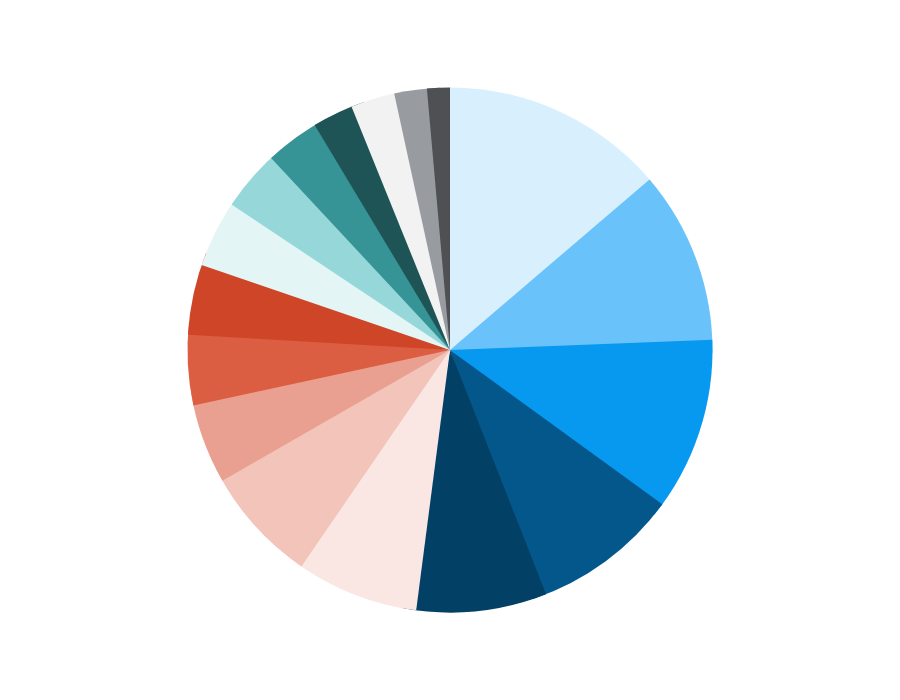What do ASBMB members work on?
In late April, the American Society for Biochemistry put out a survey asking its members what they work on. Biochemistry and molecular biology cover a lot of ground, and the responses reflected that: The members who responded work on a wide range of topics.

Primary area of interest
ASBMB members selected the following as their primary areas of research interest:
13.7% Other
10.6% Protein structure and folding
10.6% Molecular bases of disease
9% Gene regulation
8% Metabolism
7.5% Enzymology
7.1% Microbiology
4.9% Immunology
4.3% Molecular biophysics
4.3% Lipids
4.1% Neurobiology
3.7% Signal transduction
3.3% Membrane biology
2.5% Computational biology
2.7% BMB education
2% Protein synthesis and degradation
1.4% Glycobiology
Secondary area of interest
ASBMB members selected the following as their secondary areas of research interest:
16.9% Molecular bases of disease
11% Other
10.2% Protein structure and folding
8.2% Gene regulation
9.4% Signal transduction
6.5% Metabolism
5.3% Molecular biophysics
4.7% Microbiology
4.1% Immunology
3.9% BMB education
3.7% Enzymology
2.7% Protein synthesis and degradation
2.7% Neurobiology
2.5% Lipids
2.5% Computational biology
2.4% Membrane biology
1.6% Methods
The most common primary area of research was protein structure and folding, followed by molecular bases of disease, gene regulation, metabolism and enzymology.
Of those who focus primarily on protein structure and folding, 20.4% study the role of proteins in disease, 16.7% are interested in protein folding from a biophysical perspective, 11.1% work on enzymes and another 11.1% are interested in signal transduction.
As for those whose work falls primarily under the “molecular bases of disease” category, 20.4% said they are interested in signal transduction, 13% protein structure and folding, 13% gene regulation, 9.3% metabolism and 7.4% immunology.
Importantly, the options provided to respondents didn’t neatly describe everyone’s work. In fact, the top choice of primary area of interest was “other.”
Some of the interests of those who marked “other” include protein engineering, biofuels, medicinal chemistry, oncology, drug design, chemical biology and developmental biology.
Respondents also offered a lot of helpful comments. For example, some people suggested the society do more events and annual meeting sessions on the topics of DNA replication and chromosome biology, on the instruction on new research techniques and educational best practices, and on extracellular vesicles, nutritional biochemistry and cancer biology.
The society also will use these data to develop future opportunities for members to connect with other researchers working in the same field to exchange knowledge, expertise and resources. If you’d like to host a networking event at your home institution, the ASBMB will help you promote it.
And while networking with researchers in the same field is invaluable, sometimes discovery stems from less obvious connections.
After all, linking microbiology and neurology has helped elucidate the gut–brain axis and how our gut microbiomes interact with our brains; combining structural biology and genetics has helped the field of epigenetics evolve into what it is today; viewing cancer biology through the lens of immunology resulted in the development of CAR-T cell therapies. The ASBMB annual meeting, Discover BMB, brings together researchers from every field in biochemistry and molecular biology, and is an ideal venue for the conversations that spark innovation.
Thanks to all who completed the survey. We can’t wait to see the exciting collaborations and innovations that lie ahead.
Enjoy reading ASBMB Today?
Become a member to receive the print edition four times a year and the digital edition monthly.
Learn moreFeatured jobs
from the ASBMB career center
Get the latest from ASBMB Today
Enter your email address, and we’ll send you a weekly email with recent articles, interviews and more.
Latest in Careers
Careers highlights or most popular articles

Mapping proteins, one side chain at a time
Roland Dunbrack Jr. will receive the ASBMB DeLano Award for Computational Biosciences at the ASBMB Annual Meeting, March 7–10, just outside of Washington, D.C.

Exploring the link between lipids and longevity
Meng Wang will present her work on metabolism and aging at the ASBMB Annual Meeting, March 7-10, just outside of Washington, D.C.

Upcoming opportunities
Calling all biochemistry and molecular biology educators! Share your teaching experiences and insights in ASBMB Today’s essay series. Submit your essay or pitch by Jan. 15, 2026.

Defining a ‘crucial gatekeeper’ of lipid metabolism
George Carman receives the Herbert Tabor Research Award at the ASBMB Annual Meeting, March 7–10, just outside of Washington, D.C.

Building the blueprint to block HIV
Wesley Sundquist will present his work on the HIV capsid and revolutionary drug, Lenacapavir, at the ASBMB Annual Meeting, March 7–10, in Maryland.

Upcoming opportunities
Present your research alongside other outstanding scientists. The #ASBMB26 late-breaking abstract deadline is Jan. 15.

